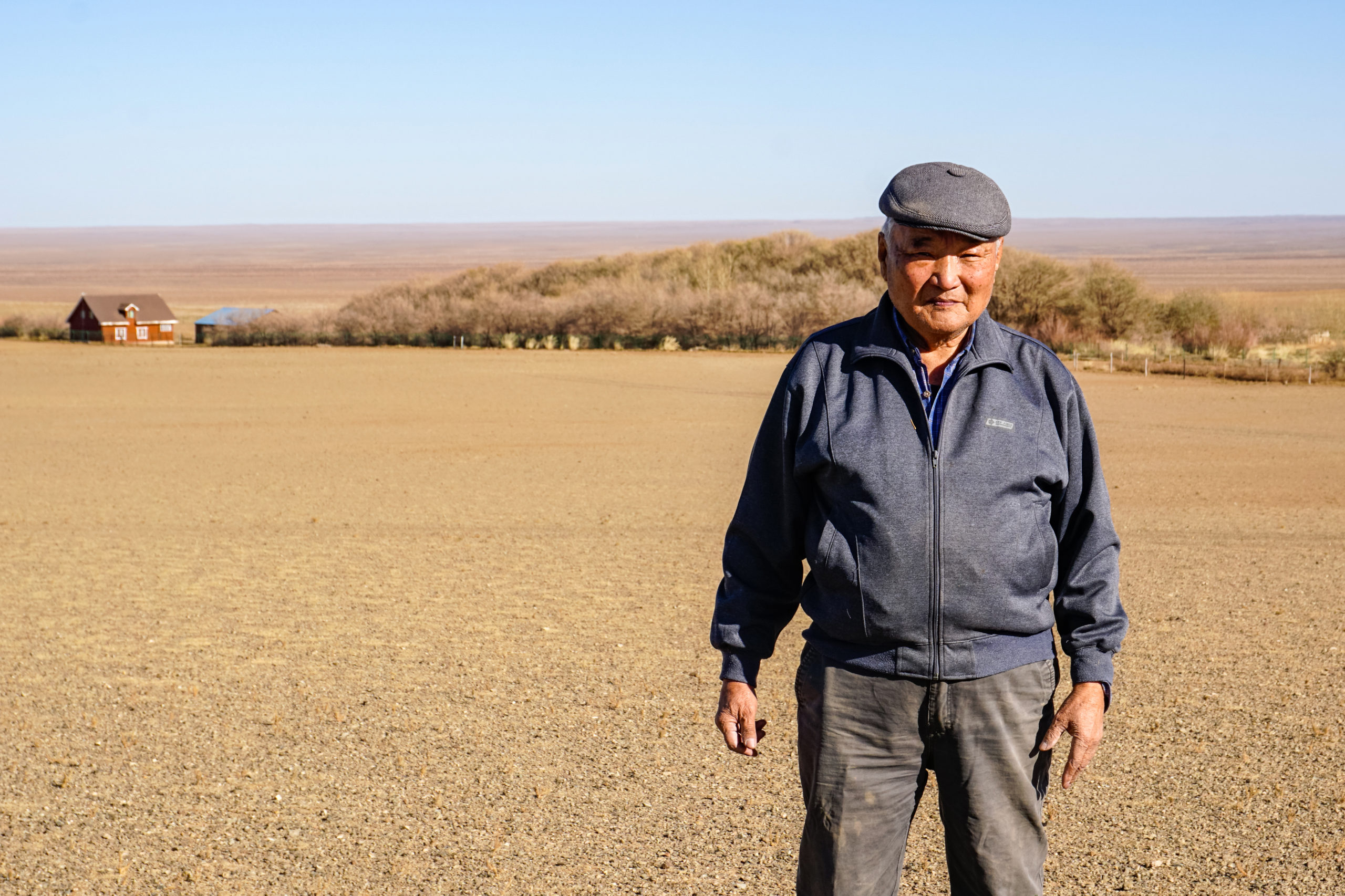
Uranchimeg Tsogkhuu, GPJ Mongolia
Baraaduuz Demchig managed to nurse hundreds of thousands of trees in his 16-hectare (about 40-acre) field in the middle of a barren desert in southern Mongolia. The tree business has weathered the pandemic better than most because it is less dependent on a foreign market.
DALANZADGAD, UMNUGOVI PROVINCE, MONGOLIA — A small forest with tall, regal trees stands out in the middle of the desert.
Baraaduuz Demchig has grown 16 hectares (about 40 acres) of greenery – and a business – on the sandy plains of southern Mongolia. He harvests apples, black currants and sea buckthorns from the fruit trees, and he makes additional income from the thousands of saplings and seedlings he sells.
It was not like this before.
When the 81-year-old started to plant crops in 1993, fierce winds blew the cabbage out of the ground. So he planted a green belt of trees to block the wind and protect the crops.
It proved an unusual decision in a place without any other forestry. Dust storms are common in the Gobi desert, which spans southern Mongolia and northern China. According to government figures, desertification affects nearly 98% of Mongolia’s largest province, Umnugovi, largely due to mining and an overabundance of livestock.



But the idea caught on thanks to diligent people like Baraaduuz, who wears a flat cap over his elegantly combed gray hair. The effort, coupled with incentives from the local government, has transformed the barren lands of the Gobi into productive fields that offer fruit and vegetables – and a livelihood.
“We grow everything that can be grown by ourselves,” he says with a warm smile, as he covers raspberry seedlings with cardboard to protect them from the brutal winter. The field provides for his family and his children’s families.
The coronavirus has crushed other sectors of the economy. But the tree nurseries have stayed resilient.
The closed borders and lockdowns caused by the pandemic shuttered businesses in Mongolia because they’re largely dependent on neighboring China, says Amartur Amgalan, head of Umnugovi’s Chamber of Commerce and Industry.



China is Mongolia’s largest trading partner, making up about 60% of total foreign trade. Around 70% of farmer and herder households say their agricultural income declined this year because of the lockdown, according to a joint survey by the National Statistics Office of Mongolia and the World Bank.
But the homegrown independence of the tree nurseries has proved key to their success.
“Tree nursery businesses are steadier compared to other sectors,” says Amartur, because they are less dependent on the foreign market. Those who raise trees can also diversify their revenue by selling fruit and vegetables, he says, which is another reason they thrive.
Odsuren Chisren, director of Ikh Goviin Tugul (Great Gobi Woods), a company that has operated a tree nursery since 2005, produces juice from the tart fruit of sea buckthorn trees.



“Because of the coronavirus, the sales and orders of our products are increasing,” says Odsuren, adding that sea buckthorn berries strengthen the immune system. These orange-yellow berries with a pleasant acidic flavor make a popular juice. The company hasn’t just sustained business this year – it’s hired about 40 people to harvest sea buckthorn fruit, he says. The business produces 700-800 juices a day to meet the increased demand.
The government has played a pivotal role in the industry’s development. The tree industry bloomed over the past decade due in part to monetary incentives for those who grew trees to fight desertification.
Since 2005, the provincial government has offered 4,500 Mongolian tugriks ($1.58) per tree for three years of planting and growing.
Residents have planted more than 92,000 trees in the past eight years, according to government figures, and officials have provided more than 120 million tugriks ($42,000) to nearly 600 people.



Oyuntuya Ayurzana planted more than 400 trees in 2010 and received about 2 million tugriks ($700) in incentives, which helped her start a tree nursery.
“Ever since we planted trees, families around us have started planting trees,” she says. She knows more than 70 households who followed suit.
Myatav Bodi, 65, is one of them. He’s proud that he bought 10 squat Siberian peashrubs to landscape his yard. “Mongolians believe that planting trees is one form of charity that should be done for being born as a human,” Myatav says. Numerous Mongolian proverbs reinforce the virtue of planting trees.
Munkhgerel Narankhuu, a specialist in forest reserve protection and afforestation from the province’s Department of Environment, says such replanting efforts lead to an increase in rainfall, critical for the water-starved Gobi.
By 2016, Umnugovi had 3.5 times more planted trees than it did in 2004. The amount of precipitation almost doubled.
With about 77% of Mongolia facing desertification and land degradation, other provinces have decided to offer similar incentives.
Baraaduuz, whose forest sprouts from the desert, hopes people continue to pay attention.
“Nothing will change if everyone just talks,” he says. “But things will change if everybody goes out with a shovel and plants trees.”
Uranchimeg Tsogkhuu is a Global Press Journal reporter based in Mongolia.
Translation Note
Otgonbaatar Tsedendemberel, GPJ, translated this article from Mongolian.








